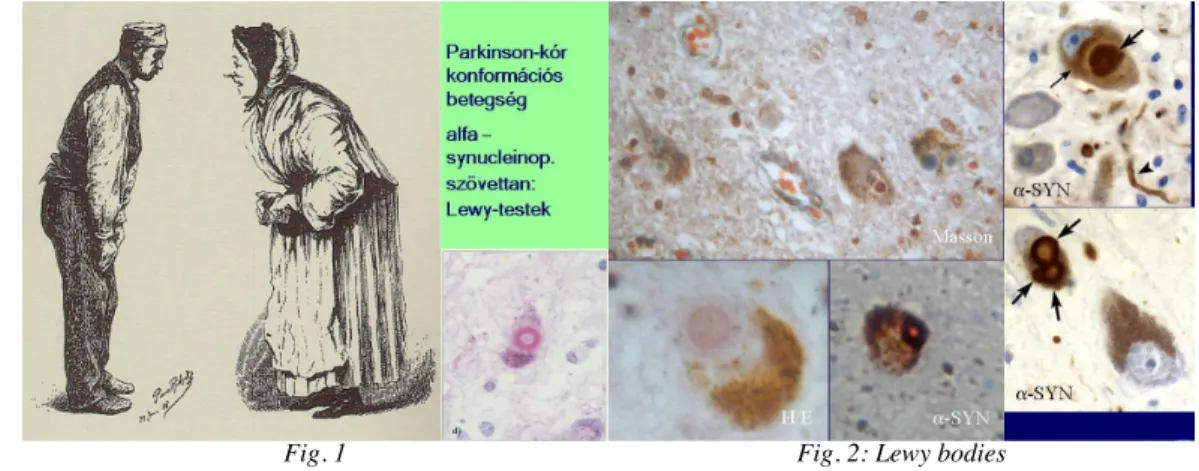III./3.1. Movement disorders with akinetic – rigid symptoms
III./3.1.1. Parkinson’s disease
Parkinson’s disease (PD) is the second most common neurodegenerative disorder worldwide after Alzheimer’s disease. Its incidence rises with age, but young-onset cases (at 30-40 years of age) are not uncommon as well. Neurodegenerative disorders,
including PD, constitute a substantial burden for Europe’s aging societies.
For this reason, following the “Decade of the Brain”, the European Union has called attention to the most frequent neurological diseases by launching the program of “Focus on Parkinson's disease” in 2008 and founding the European Brain Council. According to their data, the prevalence of PD is 200–400/100,000. By 2040, the number of patients is expected to double. In Hungary, the number of patients with PD is estimated to be around 25–30,000.
PD belongs to the group of disorders called alpha–synucleinopathies. The
histopathological landmark of the disease is the presence of Lewy bodies/inclusions containing alpha –synuclein.
Fig. 1 Fig. 2: Lewy bodies
The disease was already described several thousands years ago. The first comprehensive work mentioning all symptoms of the disease is the „An Essay on the Shaking Palsy” by James Parkinson, published in London in 1817. Recommended by Charcot, the disease was named after James Parkinson several decades later.
Fig. 3: James Parkinson and his work published in 1807
PD is classified as a movement disorder, although it has many non-motor symptoms as well.
The etiology of the disease is unknown. The “dual hypothesis” is accepted: the
combined effect of genetic and environmental factors lead to the disease. Family history is positive in 5-10 % of cases.
In PD (idiopathic Parkinson’s disease), inclusions (Lewy bodies) are found within the neurons of the substantia nigra, and in other brainstem nuclei such as the locus
coeruleus, the raphe nuclei, and the nucleus dorsalis nervi vagi. The diagnosis is based on clinical symptoms (London Brain Bank Criteria). Currently, there are no biological markers, laboratory or ancillary examinations, which can unequivocally confirm the diagnosis. Functional imaging methods may help in distinguishing between PD and atypical parkinsonian syndromes, but the routine use of these methods (PET and SPECT) is still limited. The clinical diagnosis of PD is correct in about 90% of cases.
Symptoms of PD may also occur in other neurodegenerative disorders, in drug induced and toxic parkinsonism, after central nervous system inflammation, in posttraumatic cases, and in vascular disorders. This group is called parkinsonian syndrome or atypical parkinsonism.
In addition to motor symptoms, there is an increasing body of evidence that non-motor symptoms are also present in PD. The development of non-motor and motor symptoms is explained by Braak staging.
Motor symptoms in Parkinson’s disease
There are four cardinal features of PD: bradykinesia (or hypo-akinesia), rigidity, resting tremor, and postural instability (never an early symptom). Furthermore, a flexed posture and freezing (motor blocks) are also typical. Two of the four cardinal symptoms should be present to establish the diagnosis of PD.
The so called prospective diagnostic criteria give further support to the diagnosis. These are:
- unilateral onset, presence of asymmetry throughout the course of PD - resting tremor (but one third of patients never develop tremor) - excellent levodopa response
- 40-60% of patients develop dyskinesias and motor fluctuation 5-6 years after starting levodopa treatment
Postural instability, falls and freezing (the sudden block of movements) are late motor symptoms, meaning they occur in more advanced stages of PD. The best indicator for the progression of PD is hypokinesia and postural instability. If resting tremor is the first symptom, an additional symptom (rigidity or hypokinesia) will develop within a year, as PD is never a monosymptomatic disease. PD and essential tremor may occur together.
Which movements are impaired?
Hypokinesia/bradykinesia: certain automatic movements are impaired (such as gait, speech, writing, etc.) The harmony of movements is lost. Fine, rhythmic movements are also impaired (e.g. finger tapping, hand movements, etc.) Movements are difficult to start and to terminate, and they are slowed down altogether. Patients find it difficult to turn in bed from one side to the other, and to turn when walking..
Video 1: Parkinson’s disease, early stage, main symptom is the bradykinesia of the left hand. Synkinesia of the
left arm is decreased during walking.
Rigidity: increased resistance of muscles against passive movement, usually associated with “cogwheel” phenomenon. It may be present in proximal (e.g. neck, shoulder, hip) and distal (e.g. wrist, ankle) muscles. Reinforcing maneuvers (e.g. voluntary movements in the contralateral limb) usually increase rigidity.
Resting tremor: It is the most common and easily recognized symptom of PD. Resting tremor is unilateral at onset, and has a frequency of 4–6 Hz. Hand tremor is a supination- pronation type (“pill-rolling”) tremor, which may later involve the other hand as well.
Resting tremor in PD may affect the lips, chin and legs but, unlike essential tremor, rarely affects the neck, head and voice.
Resting tremor does not lead to functional impairment for a long period of time.
Postural instability: it is due to the loss of postural reflexes, which help in maintaining our balance when balance is perturbed (e.g. while traveling on the tram, on escalators, etc.)
Other motor symptoms: dysarthria, dysphonia, dysphagia, and increased salivation are frequently observed in PD patients.
Micrography is also a motor symptom.
Postural instability and falls may be triggered by camptocornia.
Late motor symptoms: freezing of the gait, freezing of movements after initiation, sudden block of gait, postural instability, falls, motor fluctuation with dyskinesias (treatment related symptoms).
Non – motor symptoms in Parkinson’s disease
The non-motor symptoms of PD are explained by the Braak hypothesis. Braak and Braak investigated 100 human brains with PD with special emphasis on the density of Lewy bodies. They compared histopathological results with clinical data (disease onset, disease duration, etc.) and postulated that Lewy body pathology gradually spreads from the medulla oblongata to the prefrontal cortex. In the medulla oblongata stage (impaired raphe nuclei and serotonin deficiency), sleep disturbance, depression and panic attacks may occur. As PD progresses, neurons of the locus coeruleus become affected as well, causing noradrenalin deficiency and resulting in depression and REM related sleep disturbance, etc. The next stage of the disease involves the substantia nigra with the impairment of dopaminergic neurons, which results in dopamine deficiency in the striatum. The first motor symptoms of PD appear only at this stage.
The damage of structures responsible for the non-motor symptoms (raphe nuclei, pontine reticular nuclei, neurons of the locus coeruleus) precedes the impairment of substantia nigra responsible for motor symptoms. It is also possible that the impairment of these structures is simultaneous, but motor symptoms appear later, because 70-80% of dopamine deficiency is compensated by dopamine storage in the striatum, dopamine reuptake, and dopamine receptor sensitivity.
Fig.4: Braak : Lewy body density in the medulla oblongata.
Fig. 5: Impairment of substantia nigra in the 3rd pathological stage, when first motor symptoms appear
Depression and panic attacks occur in 40% of PD patients, often preceding motor symptoms. All the structures are impaired, which contain neurotransmitters playing a role in the regulation of mood (dopamine, noradrenalin, serotonin).
In the early stage of the disease, visuospatial impairment and prefrontal symptoms (recall, shifting, problem solving, abstraction, etc.) may be detected, in addition to memory impairment (working memory). The dysexecutive syndrome refers to the impairment of prefrontal cognitive functions. Dysexecutive dysfunction and memory impairment results in Parkinson’s disease dementia (PDD) in 40% of the patients.
The correlation of disease duration and development of dementia has been investigated by PET examinations. If cognitive decline (dementia) appears one year after the onset of motor symptoms, diffuse Lewy body dementia (DLBD) should be considered. In the case of early falls with prefrontal symptoms, the possibility of PSP (progressive supranuclear palsy) should be considered.
Risk factors of PD-D:
Age
Gender (males > females) Education
Severity of motor symptoms (PIGD = postural instability gait disorder)
Early cognitive decline (memory and attention deficit, dysexecutive syndrome, visuospatial disturbance)
Depression
Psychotic symptoms (hallucinations)
PD patients also have autonomic symptoms, because the hypothalamus, the
intermediolateral neurons of the spinal cord and the sympathetic ganglia are impaired, causing only subclinical symptoms in the early stage of PD.
Autonomic symptoms include disturbance of thermoregulation and blood pressure regulation (orthostatic hypotension), incontinence, and sexual dysfunction. Sleep disorders are very common in PD (REM behavior sleep disturbances, tremor,
immobility, pain, but sleep disorder may also be caused by the antiparkinsonian drugs (nightmares, hallucinations, insomnia, daytime sleepiness).
Fig. 6: REM sleep disorder with altered sleep cycles Fig. 7: Daytime sleepiness
Fig. 8: Nightmares
PD may be associated with sleep apnea, restless legs, and behavioral changes. During
„off” time, the burning sensation of extremities, pain and painful dystonia are well known complaints. Akathisia is also not uncommon.
Symptoms preceding motor manifestations (loss of smell, sleep disturbances,
depression, panic attacks, constipation) are called non- motor Parkinson’s disease rather than risk factors.


